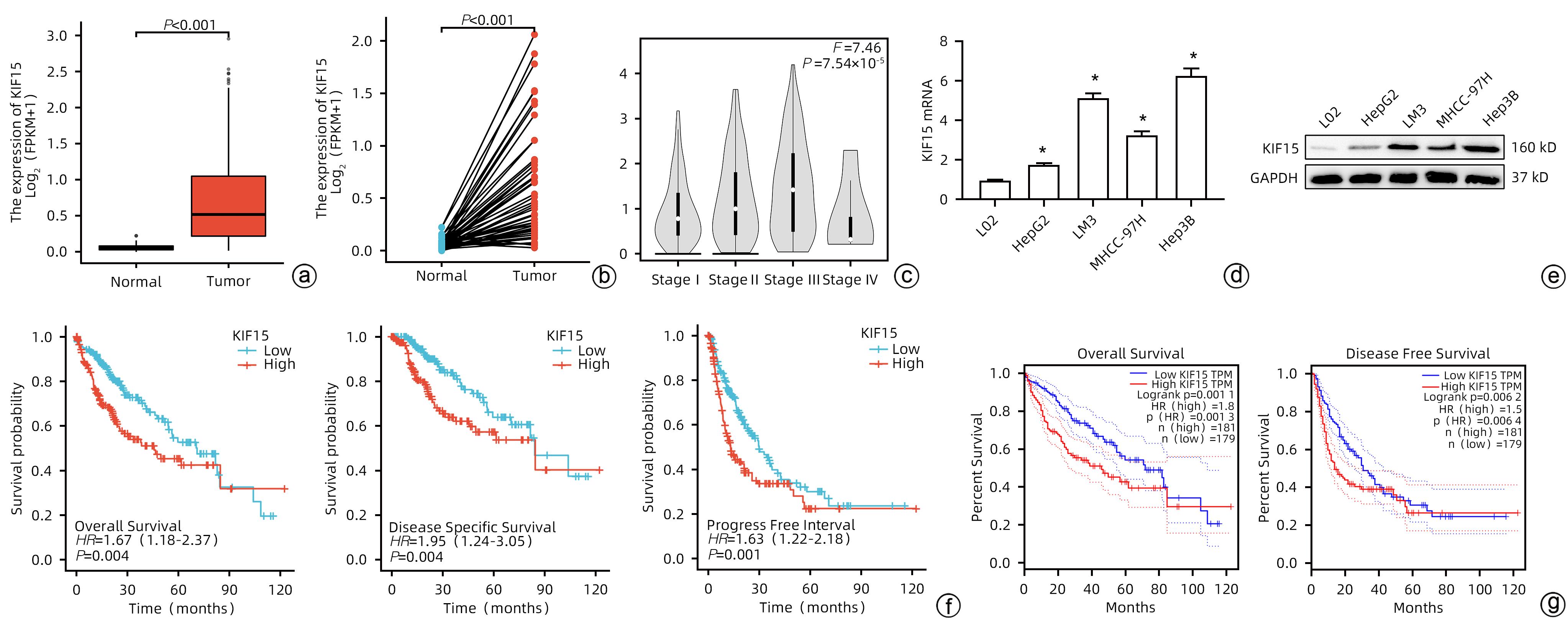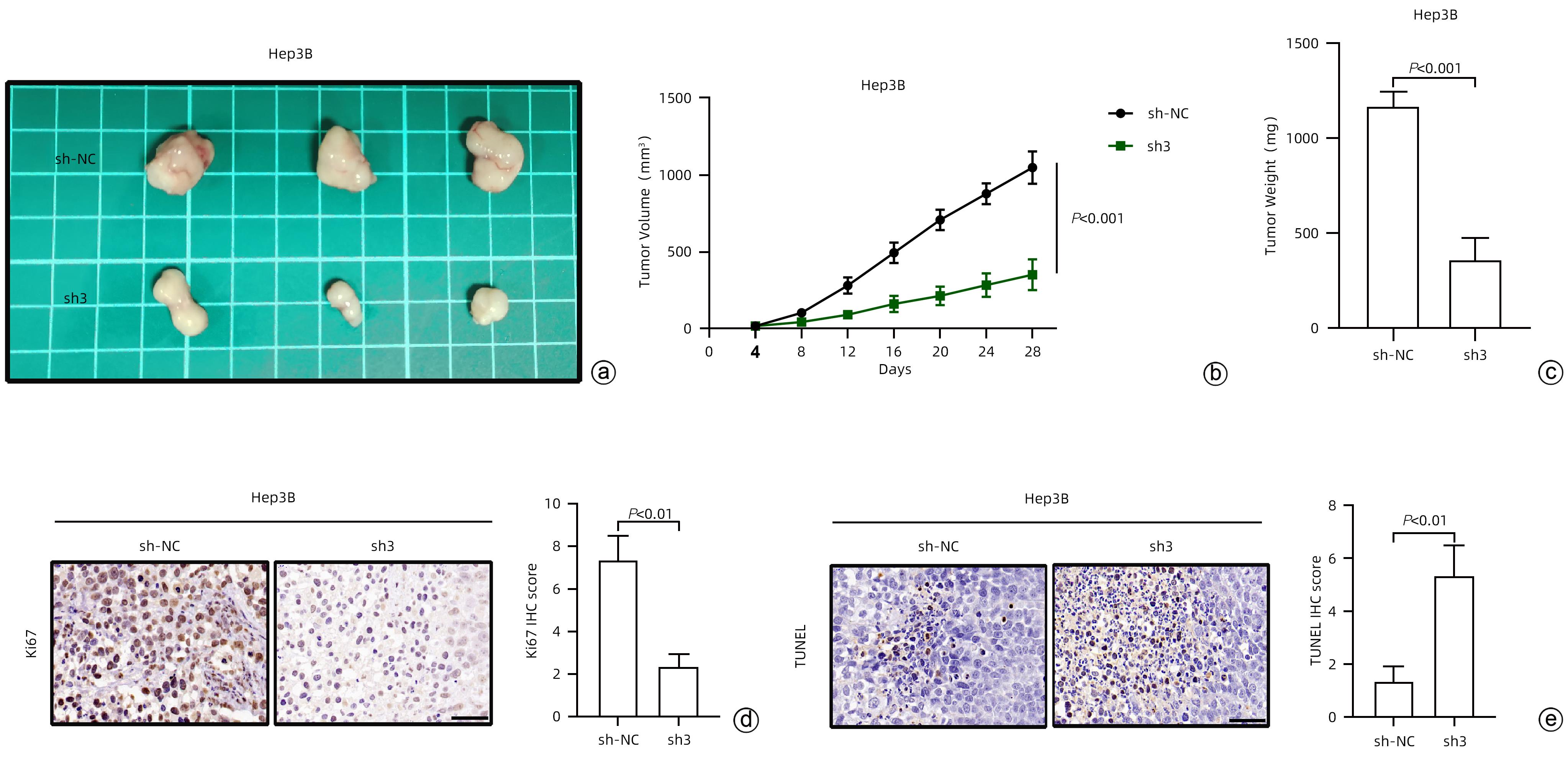驱动蛋白家族成员15(KIF15)对肝细胞癌增殖能力的影响及其作用机制
DOI: 10.12449/JCH240217
Effect of kinesin family member 15 on the proliferation of hepatocellular carcinoma cells and its mechanism of action
-
摘要:
目的 探究驱动蛋白家族成员15(KIF15)对肝细胞癌(HCC)增殖能力的影响及其作用机制。 方法 通过分析TCGA和GEPIA数据集确定KIF15在HCC中的表达情况以及对肿瘤分期、生存的影响。采用qRT-PCR和Western Blot检测体外培养的人源HCC细胞系(HepG2、Hep3B、MHCC-97H和LM3)与人正常肝细胞系L02细胞的KIF15表达水平,并选择Hep3B和HepG2进行后续研究。通过对Hep3B慢病毒转染sh-NC/sh-KIF15和对HepG2慢病毒转染LV-vector/LV-KIF15进行CCK-8、平板克隆和EdU染色实验评估细胞的活力和增殖能力。GSEA分析KIF15与HCC相关的作用信号通路并通过Western Blot进行检测。计量资料两组间比较采用成组t检验;多组间比较采用单因素方差分析,进一步两两比较采用LSD-t检验。 结果 TCGA和GEPIA数据集分析结果显示KIF15在HCC患者癌组织中的表达明显高于正常组织,并且KIF15与HCC分期成正比,KIF15高表达的HCC患者的生存更差。与sh-NC-Hep3B相比,sh3-Hep3B的KIF15 mRNA水平和蛋白水平均下降(P值均<0.05);与sh-NC-Hep3B相比,sh3-Hep3B的细胞活力、克隆形成数和EdU阳性率均显著降低(P值均<0.05)。与vector-HepG2相比,LV-KIF15-HepG2的KIF15 mRNA水平和蛋白水平均升高(P值均<0.05);与vector-HepG2相比,LV-KIF15-HepG2的细胞活力、克隆形成数和EdU阳性率均提高(P值均<0.05)。皮下瘤实验结果显示:与sh-NC-Hep3B相比,sh3-Hep3B的瘤体积和瘤重量降低;Ki67的组化评分降低,而TUNEL的组化评分提高(P值均<0.05)。GSEA分析显示在HCC中PI3K/AKT/mTOR通路与KIF15呈正相关(NES=1.59,P<0.001),Western Blot检测发现LY294002能够抑制LV-KIF15-HepG2中上调的PI3K/AKT/mTOR通路,与LV-KIF15-HepG2相比,LY294002+LV-KIF15-HepG2的细胞活力、克隆形成数和EdU阳性率降低(P值均<0.05)。 结论 KIF15通过上调PI3K/AKT/mTOR信号通路增强HCC的活力和增殖能力。 Abstract:Objective To investigate the effect of kinesin family member 15 (KIF15) on the proliferation of hepatocellular carcinoma (HCC) cells and its mechanism of action. Methods TCGA and GEPIA datasets were analyzed to determine the expression of KIF15 in HCC and its effect on tumor stage and survival. Quantitative real-time PCR and Western blot were used to measure the expression level of KIF15 in human-derived HCC cell lines (HepG2, Hep3B, MHCC-97H, and LM3) and human normal liver cell line L02 cultured in vitro, and Hep3B and HepG2 were selected for subsequent studies. CCK-8 assay, plate colony formation assay, and EdU staining were performed for Hep3B cells transfected with shRNA-NC or shRNA-KIF15 and HepG2 cells transfected with LV-vector or LV-KIF15 to evaluate the viability and proliferative capacity of these cells. GSEA was used to analyze the potential signaling pathways associated with KIF15 in HCC, and Western blot was used for detection. The independent-samples t test was used for comparison of continuous data between two groups; a one-way analysis of variance was used for comparison between multiple groups, and the least significant difference t-test was used for further comparison between two groups. Results The analysis of TCGA and GEPIA datasets showed that in HCC patients, the expression of KIF15 in HCC tissue was significantly higher than that in normal tissue, and the HCC patients with high KIF15 expression tended to have a poorer prognosis. Compared with sh-NC-Hep3B, sh3-Hep3B showed significant reductions in the mRNA and protein levels of KIF15 (P<0.05), cell viability, clone formation number, and EdU positive rate (all P<0.05). Compared with vector-HepG2, LV-KIF15-HepG2 showed significant increases in the mRNA and protein levels of KIF15 (P<0.05), cell viability, clone formation number, and EdU positive rate (all P<0.05). Subcutaneous tumor assay showed that compared with sh-NC-Hep3B, sh3-Hep3B showed reductions in tumor volume and tumor weight, as well as a significant reduction in the immunohistochemical score of Ki67 and a significant increase in the immunohistochemical score of TUNEL (P<0.05). GSEA analysis showed that the PI3K/AKT/mTOR pathway was positively correlated with KIF15 in HCC (NES=1.59, P<0.001). Western blot showed that LY294002 could inhibit the PI3K/AKT/mTOR pathway upregulated in LV-KIF15-HepG2, and compared with LV-KIF15-HepG2, LY294002+LV-KIF15-HepG2 showed significant reductions in cell viability, clone formation number, and EdU positive rate (all P<0.05). Conclusion KIF15 enhances the viability and proliferative capacity of HCC cells by upregulating the PI3K/AKT/mTOR signaling pathway. -
Key words:
- Carcinoma, Hepatocellular /
- Kinesin /
- Signal Transduction /
- Cell Proliferation
-
原发性肝癌是全球常见的恶性肿瘤之一,据全球最新癌症负担数据(Globocan 2020)显示,其发病率居恶性肿瘤发病第6位,2020年全球肝癌新增人数为90.6万,年龄标化发病率约9.5/10万;该病预后差,位列全球常见恶性肿瘤死因第3位,2020年全球肝癌死亡人数为83.0万,年龄标化死亡率为8.7/10万[1]。尽管当前诊疗技术迅速发展,但因肝癌起病隐匿、进展迅速,绝大部分患者确诊时已进展至肝癌晚期[2]。近些年通过针对肝炎病毒、黄曲霉素食品污染等因素的有效控制,我国肝癌发病率和死亡率呈下降趋势,但肝癌患者5年生存率仍仅为12.1%[3-5]。同时,我国肝癌所致的伤残寿命年仍占比全球肝癌负担的近50%[6]。通过探究其与其他因素间的因果关系对揭示肝癌的深层病理机制、采取有效临床干预措施和制订公共卫生政策具有重要意义[7-9]。
针对疾病因果推断,随机对照试验(RCT)是流行病学研究中最为可靠的方法,但因其本身存在研究周期长、人力物力消耗大、涉及医学伦理等问题,很难实现科学性与可行性的统一。随着统计学与基因技术的更新迭代,基于全基因组关联研究(genome-wide association study,GWAS)大数据样本的孟德尔随机化应运而生,其是以与风险因素相关的遗传变异作为工具变量,推测风险因素与疾病之间的因果关联,能够有效规避RCT的束缚及因果推断中的干扰问题。
肿瘤性疾病的防治迄今仍是困扰医学界的难题之一,其错综复杂的调控网络使人们对其发病机制及病因学研究仍十分受限。近年来,孟德尔随机化因其特有的优势被越来越多地应用于肿瘤性疾病的病因研究,如探索身体质量指数与肺癌[10]、乙醇摄入与食管癌[11]、睡眠特征与乳腺癌[12]等的因果效应。本文主要介绍孟德尔随机化并探讨其在肝癌研究中的应用进展,旨在为肝癌的因果关联研究提供新思路。
1. 孟德尔随机化的介绍
孟德尔随机化最初是由Katan[13]于1986年首次提出,是一种以遗传变异作为工具变量的统计模型,利用工具变量替代暴露因素构建“工具变量-暴露-结局”的因果路径,通过“工具变量-结局”效应模拟“暴露-结局”的因果关联。孟德尔随机化以孟德尔分离定律为理论基础,即“影响亲本性状的等位基因在形成配子时,随减数分裂随机分配给子代”,因此工具变量不会受到出生后环境暴露、社会经济地位、行为因素等传统混杂因素影响;且出生后保持不变,与结局间具有时间顺序合理性,因此具有规避反向因果的独特优势。
常用孟德尔随机化包括独立样本孟德尔随机化、两样本孟德尔随机化、多变量孟德尔随机化、双向孟德尔随机化和网络孟德尔随机化等[14],其模型中工具变量的选择必须满足3个核心假设[15-16]。(1)关联性假设:工具变量与暴露间必须是稳健的强相关关系;(2)独立性假设:工具变量不能与影响“暴露-结局”的混杂因素有关联;(3)排他性假设:工具变量只能通过暴露对结局产生效应。若不符合关联性假设,就会导致工具变量对暴露因素的解释强度不足引起弱工具变量问题;倘若违背独立性/排他性出现多效性效应将会导致无效工具变量的产生。在实际应用中,可采用孟德尔随机化-Egger[17]、漏斗图、Q检验等敏感性分析以及等位基因加权评分、众数评分法等加权法的应用来排除内生性误差导致的干扰,亦即“偏倚矫正”[18]。
孟德尔随机化研究虽能有效避免观察性研究(混杂因素、反向因果关系以及回归稀释偏倚等)和RCT(代表性和可行性问题)在进行因果推断时的限制,但当下仍存在不足:(1)核心假设的合理性是孟德尔随机化因果关联研究的前提,而弱工具变量、遗传变异多效性、连锁不平衡、人群分层等易导致核心假设的违背,如弱工具变量偏倚会导致单样本孟德尔随机化研究中暴露-结局关联被高估,而遗传多效性可能导致独立性假设或排他性假设不成立。此外,假设亦受Beavis效应、发育代偿机制等影响[19-20]。(2)考虑到生物学复杂性的存在,复杂疾病涉及基因组、转录组、代谢组等不同层次生物学过程,孟德尔随机化只能初步判断暴露-结局间的因果关联,针对其关联机制尚未完全阐明,导致全面检验假设并获得真实的因果效应值还难以实现。(3)成果转化及应用方面存在困难。目前,孟德尔随机化研究仅能提供危险因素的终身暴露对结局的影响,难以揭示疾病不同发展阶段的因果效应,仍需更多高质量RCT证据的补充与支持。
2. 孟德尔随机化在肝癌研究中的应用
目前,孟德尔随机化已经在肝癌研究领域有了一定范围的应用,主要包括肠道菌群、循环代谢物、特定疾病、生活行为方式及炎症标志物与肝癌的因果关系,以下就每个领域分别进行阐述。
2.1 肠道菌群与肝癌
肠道菌群作为体内微生物的重要部分,被称为“人类的第二基因组”[21-22],其组成与结构变化与人类健康及疾病发生息息相关。近年来研究[23-25]发现肝癌宿主存在肠道菌群结构与数量的改变。Ren等[24]通过对早期肝癌、肝硬化患者肠道菌群特征分析,发现肝癌组和肝硬化组的肠道菌群多样性对比健康对照组发生明显改变,尤以肝癌组改变最为明显,如产脂多糖菌属显著增加,而丁酸盐产生菌显著减少。这种特异改变提示可以通过菌群特异性分析作为早期肝癌的非侵入性诊断工具。为了进一步验证肠道菌群与肝癌发生发展的因果关系,Ma等[26]通过利用肠道微生物组和肝癌的GWAS汇总数据进行两样本孟德尔随机化研究,共筛选出14~21个单核苷酸多态性(single nucleotide polymorphism,SNP)(包括2个科和2个属的肠道微生物组)用于孟德尔随机化分析,研究发现瘤胃菌科(OR=0.46,95%CI:0.26~0.82,P=0.009)和紫单胞菌属(OR=0.59,95%CI:0.42~0.83,P=0.003)与肝癌具有保护性因果关系,以及紫单胞菌科(OR=0.36,95%CI:0.14~0.94,P=0.036)和拟杆菌属(OR=0.55,95%CI:0.34~0.90,P=0.017)与肝癌具有保护性因果关系,并使用临床病例对照测序数据验证了这一因果关系,得出瘤胃菌科、紫单胞菌科及拟杆菌属相对丰度增加可以降低肝癌发生风险,提示该类菌群可能是预防和治疗肝癌的潜在手段,对预防和控制肝癌发生具有重要意义。但由于生物学机制复杂性,肠道菌群与肝癌之间的双向因果关系仍需更多证据论证。
2.2 甲状腺功能减退与肝癌
甲状腺激素的主要生理作用是促进机体新陈代谢,维持机体的正常生长发育,而肝脏是其主要代谢场所,在其合成、转化及灭活中发挥重要作用。目前临床研究发现甲状腺激素/甲状腺激素受体参与多种癌症进展,包括卵巢癌、前列腺癌、乳腺癌、肝癌、肺癌及结直肠癌等[27-31]。Pinter等[32]研究发现促甲状腺激素(thyroid stimulating hormone,TSH)和游离甲状腺素(free thyroxine,FT4)水平与肿瘤大小高度相关,且高浓度FT4与不良预后独立相关。Sahin等[33]通过对比研究肝硬化后肝癌患者,发现肝癌组血清游离三碘甲状腺原氨酸水平显著高于肝硬化组,提示其与肝癌的发生发展有密切关系。Chu等[34]研究发现较高水平TSH和FT4与良好的肿瘤无进展期及总体生存率独立相关,但这种相关性在针对接受索拉非尼治疗以及全身化疗的晚期肝癌患者中截然相反。Hassan等[35]和Reddy等[36]通过病例对照研究发现,持续时间超过3年的甲状腺功能减退患者发生肝癌风险显著增加,女性患者尤甚,提示甲状腺功能减退可能是肝癌的独立危险因素。Bruck等[37]和Oren等[38]通过药理学诱导大鼠甲状腺功能减退发现其可改善大鼠肝纤维化,而甲状腺功能亢进加剧肝硬化进展。以上观察性研究均表明,异常的甲状腺激素水平与肝病发展密切相关。Yuan等[39]通过孟德尔随机化研究并没有发现甲状腺激素与肝癌之间存在因果关联(OR=0.82,95%CI:0.55~1.23,P=0.336),而Lu等[40]通过扩大研究人群样本量(337 159名欧洲裔)后发现甲状腺功能减退与肝癌之间存在负相关(OR=0.997,95%CI:0.995~0.999,P=0.016),同时发现TSH水平和FT4水平与肝癌风险没有直接的因果关系,说明甲状腺功能减退对肝癌的保护作用可能不是通过甲状腺激素实现的,具体机制还有待进一步研究。值得指出的是,该研究中TSH和FT4相关暴露样本量较少(72 167个),未来仍需进一步扩大样本量明确其与肝癌之间的因果关系。
2.3 生活方式因素与肝癌
观察性研究显示许多生活方式因素与肝癌风险相关,但这些生活方式与肝癌之间是否存在明确的因果关联以及通过改变这些因素是否能降低肝癌的患病风险尚不清楚。肥胖被认为是促进肿瘤发生的一个因素,吴燕梅[41]在中国人群中首次利用孟德尔随机化方法探讨肥胖与肝癌发生的因果关联,发现肥胖可能为肝癌发生的危险因素。而Zhang等[42]通过临床试验和孟德尔随机化研究发现肥胖在女性肝癌患病中起保护作用,通过生物信息学分析确定钴胺素相关A代谢基因(metabolism of cobalamin-associated A,MMAA)为肥胖差异基因及肝癌的预后指标,并证明了MMAA是雌激素受体1的下游作用靶点,雌激素受体1通过调控MMAA在肝癌中的过表达抑制癌细胞的增殖、迁移和侵袭,增加细胞凋亡率,并维持了线粒体功能障碍所致的氧化还原平衡,进一步阐明了肥胖可能是女性肝癌患者的保护因素。
目前,众多研究显示饮酒是肝癌的危险因素之一[43],尽管大量饮酒与患肝癌的风险有较好的相关性,但低至中度饮酒是否与肝癌患病风险成反比仍存在争议。Liu等[44]通过前瞻性队列研究和非线性孟德尔随机化分析发现,饮酒(仅指葡萄酒)与肝癌患病低风险亚组(如女性、年龄<60岁,以及ALT水平正常和无风险基因变异的人群)呈J型相关,这也证实了先前的研究结果[45-46]:低至中度饮酒与肝癌患病风险呈负相关。同时该研究指出针对肝癌患病的高风险亚组(包括男性、年龄≥60岁、ALT异常以及携带PNPLA3 rs738409和TM6SF2 rs58542926风险等位基因)人群,其饮酒与肝癌风险之间存在线性关系,应完全戒酒。同样,很多学者[47-50]针对饮食习惯与肝癌的孟德尔随机化研究发现曾经/从未饮酒和饮酒量与肝癌风险呈正相关(不饮酒者患肝癌的风险增加41%),而咖啡、茶、奶制品等的摄入与肝癌患病风险成反比。
2.4 循环代谢物与肝癌
目前,维生素D因其抗肿瘤效应在肿瘤病因学研究中备受瞩目,但结论不一。多项观察性流行病学研究[51-52]表示维生素D水平与多种癌症风险呈显著负相关,尤其对肝癌患病风险影响最大。Lange等[53]通过孟德尔随机化探索维生素D与肝癌关系的研究却表明,维生素D水平降低可能与丙型肝炎患者进展为肝癌的风险有关,但未发现维生素D与经抗病毒治疗后的HCV感染相关肝癌存在因果关联,提示维生素D对丙型肝炎相关肝癌发生有特定的影响。Liu等[54]应用两样本孟德尔随机化研究发现血液高水平25(OH)D(≥20 ng/mL与肝癌患病风险相关(OR=5.48,95%CI:2.91~10.30,P<0.001),且通过循环中25(OH)D水平与其相关rs12785878基因的交互作用可以显著延长肝癌患者的总生存期和无瘤生存期,但并没有发现25(OH)D浓度相关的基因变异与肝癌复发和死亡率之间有关联。需指出的是该研究仅筛选出6个SNP,同时缺少对混杂变量(如户外活动时间等)的调整。而钟旋[55]针对我国南方人群使用孟德尔随机化方法探讨维生素D水平/缺乏与肝癌发病风险,利用遗传变异构建遗传风险评分,代替单一变异作为工具变量,解决了常见变异的弱工具变量问题以及受基因多效性影响等弊端,提高了工具变量的效率,并在此基础上进行敏感性分析,并未发现维生素D水平/缺乏对肝癌的发生风险有影响。未来仍需纳入更多遗传变异、更大规模的孟德尔随机化研究进一步去验证。此外,多项RCT的Meta分析显示补充维生素D有助于降低癌症死亡率,而不是癌症发病率[56-57],后续研究或可进一步探讨维生素D与肝癌预后进展或死亡之间的关系。
观察性研究[58-61]显示癌症患者的循环TGF-β1浓度明显高于健康对照组,Lu等[62]通过选择TGF-β1基因C-509T多态性作为工具变量,检验血清TGF-β1与肝癌的因果关系,发现C-509T多态性与肝癌没有关联,但其与循环TGF-β1的关联具有统计学意义,进一步孟德尔随机化分析表明,在同种基因型和显性模式下,循环TGF-β1每增加一单位,肝癌风险各增加38%(95%CI:1.03~4.65)和49%(95%CI:1.01~6.06),从而确定了血清TGF-β1升高与肝癌患病风险增加有因果关联。
Yuan等[63]利用两样本孟德尔随机化研究铁状态与癌症风险,发现铁状态与肝癌患病风险呈正相关,但其只筛选到3个SNP作为工具变量,存在弱工具变量问题。而Tian等[8]进一步利用单变量和多变量孟德尔随机化分析并没有发现铁状态(血清铁、铁蛋白、转铁蛋白)与肝癌风险之间的因果关系,但该项GWAS数据病例规模较小且病例对照比不平衡,存在统计效能偏差,未来仍需更加完善的GWAS数据进一步验证。
2.5 炎症标志物与肝癌
炎症细胞浸润与肿瘤的发生、发展及临床疗效密切相关,有学者[64]发现白细胞端粒长度与肝癌之间存在U型因果联系,即端粒长度的增加或减少均会导致肝癌患病风险的增加。Pan等[65]首次利用多变量孟德尔随机化探究白细胞亚型计数与肝细胞癌风险之间的因果关系,发现在欧洲裔人群中,基因预测的低嗜碱性粒细胞总数与肝细胞癌患病风险存在因果关联,这一发现为临床医生诊疗肝细胞癌提供了新思路,但仍需在不同人群中进一步验证。
3. 展望
孟德尔随机化作为一种非常强大的流行病学研究方法,随着GWAS数据不断开发及孟德尔随机化模型的不断规范,被越来越多地应用于探索疾病的危险因素、疾病的中间机制和复杂疾病间的双向因果关联等。然而,由于基因的复杂性,其潜在相关生物学机制仍无法充分阐明,但这无法掩盖其为疾病间的因果关联探索提供的宝贵思路,相信随着遗传流行病学的不断发展及统计学算法的不断完善,孟德尔随机化有望成为传统观察性研究与RCT之间因果证据链的重要纽带。
-
注: a,GSEA分析KIF15在HCC中潜在的作用通路;b,Western Blot验证Hep3B细胞中PI3K/AKT/mTOR通路表达情况;c、d,Western Blot验证HepG2细胞中PI3K/AKT/mTOR通路表达情况;e,CCK-8实验分析HepG2细胞增殖活力;f,克隆形成实验分析HepG2细胞克隆数;g,EdU实验分析HepG2细胞增殖活力。
图 4 KIF15对HCC增殖能力影响的机制探究
Figure 4. The mechanism of the effect of KIF15 on the proliferation of hepatocellular carcinoma
表 1 Western Blot 检测KIF15蛋白在HCC细胞株中的表达水平
Table 1. The protein expression level of KIF15 in HCC cell lines by Western Blot
组别 KIF15 L02 1.00±0.02 HepG2 1.45±0.101) LM3 5.22±0.391) MHCC-97H 3.49±0.251) Hep3B 7.69±0.611) F值 192.40 P值 <0.001 注:与L02组比较,1)P<0.05。 表 2 Western Blot 检测KIF15蛋白在Hep3B中的表达水平
Table 2. The protein expression level of KIF15 in Hep3B by Western Blot
分组 KIF15 sh-NC 1.00±0.08 sh1 0.54±0.141) sh2 0.66±0.081) sh3 0.15±0.051) F值 41.63 P值 <0.001 注:与sh-NC组比较,1)P<0.05。 表 3 Western Blot 检测Hep3B细胞中相关蛋白表达结果
Table 3. Western Blot analysis was performed to determine the expression levels of related proteins in Hep3B cells
分组 KIF15 p-PI3K/PI3K p-AKT/AKT p-mTOR/mTOR sh-NC 1.05±0.10 0.99±0.06 0.99±0.06 0.98±0.07 sh3 0.19±0.03 0.14±0.04 0.24±0.05 0.22±0.02 t值 13.88 19.66 16.71 17.48 P值 <0.001 <0.001 <0.001 <0.001 表 4 Western Blot 检测HepG2细胞中相关蛋白表达结果
Table 4. Western Blot analysis was performed to determine the expression levels of related proteins in HepG2 cells
分组 KIF15 p-PI3K/PI3K p-AKT/AKT p-mTOR/mTOR vector 1.00±0.06 1.04±0.10 1.02±0.06 0.96±0.04 KIF15 6.12±0.20 5.11±0.22 4.56±0.49 4.56±0.55 t值 41.97 29.29 12.46 11.24 P值 <0.001 <0.001 <0.001 <0.001 表 5 LY294002抑制剂干预对HepG2细胞中相关蛋白表达的影响
Table 5. The effect of inhibitor LY294002 intervention on the expression of related proteins in HepG2 cells
分组 KIF15 p-PI3K/PI3K p-AKT/AKT p-mTOR/mTOR vector 1.06±0.13 1.01±0.09 0.96±0.08 0.97±0.05 KIF15 5.68±0.35 4.64±0.57 4.70±0.51 4.82±0.37 KIF15+LY294002 5.42±0.251) 1.17±0.091) 1.07±0.121) 1.22±0.101) F值 301.05 111.64 145.32 284.41 P值 <0.001 <0.001 <0.001 <0.001 注:与KIF15组比较,1)P<0.05。 -
[1] YU SJ. Immunotherapy for hepatocellular carcinoma: Recent advances and future targets[J]. Pharmacol Ther, 2023, 244: 108387. DOI: 10.1016/j.pharmthera.2023.108387. [2] BROWN ZJ, TSILIMIGRAS DI, RUFF SM, et al. Management of hepatocellular carcinoma: A review[J]. JAMA Surg, 2023, 158( 4): 410- 420. DOI: 10.1001/jamasurg.2022.7989. [3] ALMEIDA AC, MAIATO H. Chromokinesins[J]. Curr Biol, 2018, 28( 19): R1131- R1135. DOI: 10.1016/j.cub.2018.07.017. [4] BEGLEY MA, SOLON AL, DAVIS EM, et al. K-fiber bundles in the mitotic spindle are mechanically reinforced by Kif15[J]. Mol Biol Cell, 2021, 32( 22): br11. DOI: 10.1091/mbc.E20-06-0426. [5] LUO Y, ZHANG B, XU L, et al. Downregulation of KIF15 inhibits the tumorigenesis of non-small-cell lung cancer via inactivating Raf/MEK/ERK signaling[J]. Histol Histopathol, 2022, 37( 3): 269- 285. DOI: 10.14670/HH-18-408. [6] GE W, CHEN Y, GUO Y, et al. KIF15 upregulation promotes leiomyosarcoma cell growth via promoting USP15-mediated DEK deubiquitylation[J]. Biochem Biophys Res Commun, 2021, 570: 117- 124. DOI: 10.1016/j.bbrc.2021.07.042. [7] TAO J, SUN G, LI Q, et al. KIF15 promotes the evolution of gastric cancer cells through inhibition of reactive oxygen species-mediated apoptosis[J]. J Cell Physiol, 2020, 235( 12): 9388- 9398. DOI: 10.1002/jcp.29743. [8] RUMGAY H, ARNOLD M, FERLAY J, et al. Global burden of primary liver cancer in 2020 and predictions to 2040[J]. J Hepatol, 2022, 77( 6): 1598- 1606. DOI: 10.1016/j.jhep.2022.08.021. [9] SUN Y, ZHANG W, BI X, et al. Systemic therapy for hepatocellular carcinoma: Chinese consensus-based interdisciplinary expert statements[J]. Liver Cancer, 2022, 11( 3): 192- 208. DOI: 10.1159/000521596. [10] SIEGEL RL, MILLER KD, FUCHS HE, et al. Cancer statistics, 2022[J]. CA Cancer J Clin, 2022, 72( 1): 7- 33. DOI: 10.3322/caac.21708. [11] Chinese Association of Liver Cancer of Chinese Medical Doctor Association. Chinese expert consensus on the whole‐course management of hepatocellular carcinoma(2023 edition)[J]. Chin J Dig Surg, 2023, 22( 7): 824- 842. DOI: 10.3760/cma.j.cn115610-20230605-00261.中国医师协会肝癌专业委员会. 肝细胞癌全程管理中国专家共识(2023版)[J]. 中华消化外科杂志, 2023, 22( 7): 824- 842. DOI: 10.3760/cma.j.cn115610-20230605-00261. [12] ZHANG S, TU Q, QIAN X, et al. Deficiency of Kif15 gene inhibits tumor growth due to host CD8+T lymphocytes increase[J]. Biochem Biophys Res Commun, 2023, 655: 110- 117. DOI: 10.1016/j.bbrc.2023.03.006. [13] VANNESTE D, FERREIRA V, VERNOS I. Chromokinesins: localization-dependent functions and regulation during cell division[J]. Biochem Soc Trans, 2011, 39( 5): 1154- 1160. DOI: 10.1042/BST0391154. [14] HE Z, WANG J, XU J, et al. Dynamic regulation of KIF15 phosphorylation and acetylation promotes focal adhesions disassembly in pancreatic cancer[J]. Cell Death Dis, 2022, 13( 10): 896. DOI: 10.1038/s41419-022-05338-y. [15] SUN RF, HE N, ZHANG GY, et al. Combined inhibition of KIF11 and KIF15 as an effective therapeutic strategy for gastric cancer[J]. Curr Cancer Drug Targets, 2023, 23( 4): 293- 306. DOI: 10.2174/1568009622666220616122846. [16] QUAN G, XU J, WANG J, et al. KIF15 is essential for USP10-mediated PGK1 deubiquitination during the glycolysis of pancreatic cancer[J]. Cell Death Dis, 2023, 14( 2): 137. DOI: 10.1038/s41419-023-05679-2. [17] WANG L, ZHANG X, LIU J, et al. Kinesin family member 15 can promote the proliferation of glioblastoma[J]. Math Biosci Eng, 2022, 19( 8): 8259- 8272. DOI: 10.3934/mbe.2022384. [18] MI J, MA S, CHEN W, et al. Integrative pan-cancer analysis of KIF15 reveals its diagnosis and prognosis value in nasopharyngeal carcinoma[J]. Front Oncol, 2022, 12: 772816. DOI: 10.3389/fonc.2022.772816. [19] GAO L, ZHANG W, ZHANG J, et al. KIF15-mediated stabilization of AR and AR-V7 contributes to enzalutamide resistance in prostate cancer[J]. Cancer Res, 2021, 81( 4): 1026- 1039. DOI: 10.1158/0008-5472.CAN-20-1965. [20] CHAN YT, LIN RJ, WANG YH, et al. The interplay between IGF-1R signaling and Hippo-YAP in breast cancer stem cells[J]. Cell Commun Signal, 2023, 21( 1): 81. DOI: 10.1186/s12964-023-01088-2. [21] TIAN LY, SMIT DJ, JÜCKER M. The role of PI3K/AKT/mTOR signaling in hepatocellular carcinoma metabolism[J]. Int J Mol Sci, 2023, 24( 3): 2652. DOI: 10.3390/ijms24032652. [22] LIU M, HUANG XD, HAN Z, et al. Effect of cadherin-17 on proliferation and apoptosis of colorectal cancer cells and its PI3K/AKT/m TOR signaling pathway regulatory mechanism[J]. J Jilin Univ(Med Edit), 2023, 49( 4): 1008- 1017. DOI: 10.13481/j.1671-587X.20230423.刘蒙, 黄晓东, 韩峥, 等. 钙黏蛋白17对结直肠癌细胞增殖和凋亡的影响及其PI3K/AKT/mTOR信号通路调节机制[J]. 吉林大学学报(医学版), 2023, 49( 4): 1008- 1017. DOI: 10.13481/j.1671-587X.20230423. [23] JIANG Q, GUAN Y, ZHENG J, et al. TBK1 promotes thyroid cancer progress by activating the PI3K/Akt/mTOR signaling pathway[J]. Immun Inflamm Dis, 2023, 11( 3): e796. DOI: 10.1002/iid3.796. [24] LI Y, WANG S, JIN K, et al. UHMK1 promotes lung adenocarcinoma oncogenesis by regulating the PI3K/AKT/mTOR signaling pathway[J]. Thorac Cancer, 2023, 14( 12): 1077- 1088. DOI: 10.1111/1759-7714.14850. [25] CHEN J, LIU F, WU J, et al. Effect of STK3 on proliferation and apoptosis of pancreatic cancer cells via PI3K/AKT/mTOR pathway[J]. Cell Signal, 2023, 106: 110642. DOI: 10.1016/j.cellsig.2023.110642. 期刊类型引用(2)
1. 杨新,刘志新,刘娇,杨卓,安娜. 甲状旁腺激素样激素与肝细胞癌免疫浸润相关性及其对患者预后预测价值. 临床军医杂志. 2024(04): 425-429 .  百度学术
百度学术2. 王一晨,谷慧敏,陈宇华,刘畅,崔家康,孟庆良. 孟德尔随机化在类风湿关节炎相关研究中的应用. 陕西医学杂志. 2024(11): 1562-1566 .  百度学术
百度学术其他类型引用(0)
-




 PDF下载 ( 1773 KB)
PDF下载 ( 1773 KB)


 下载:
下载:



 百度学术
百度学术

